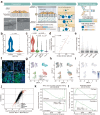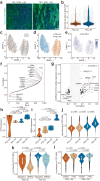High-throughput mechanical phenotyping and transcriptomics of single cells
- PMID: 38760380
- PMCID: PMC11101642
- DOI: 10.1038/s41467-024-48088-5
High-throughput mechanical phenotyping and transcriptomics of single cells
Abstract
The molecular system regulating cellular mechanical properties remains unexplored at single-cell resolution mainly due to a limited ability to combine mechanophenotyping with unbiased transcriptional screening. Here, we describe an electroporation-based lipid-bilayer assay for cell surface tension and transcriptomics (ELASTomics), a method in which oligonucleotide-labelled macromolecules are imported into cells via nanopore electroporation to assess the mechanical state of the cell surface and are enumerated by sequencing. ELASTomics can be readily integrated with existing single-cell sequencing approaches and enables the joint study of cell surface mechanics and underlying transcriptional regulation at an unprecedented resolution. We validate ELASTomics via analysis of cancer cell lines from various malignancies and show that the method can accurately identify cell types and assess cell surface tension. ELASTomics enables exploration of the relationships between cell surface tension, surface proteins, and transcripts along cell lineages differentiating from the haematopoietic progenitor cells of mice. We study the surface mechanics of cellular senescence and demonstrate that RRAD regulates cell surface tension in senescent TIG-1 cells. ELASTomics provides a unique opportunity to profile the mechanical and molecular phenotypes of single cells and can dissect the interplay among these in a range of biological contexts.
© 2024. The Author(s).
Conflict of interest statement
The authors declare no competing interests.
Figures



Similar articles
-
Analysis of individual cells identifies cell-to-cell variability following induction of cellular senescence.Aging Cell. 2017 Oct;16(5):1043-1050. doi: 10.1111/acel.12632. Epub 2017 Jul 11. Aging Cell. 2017. PMID: 28699239 Free PMC article.
-
Single-cell characterization of haematopoietic progenitors and their trajectories in homeostasis and perturbed haematopoiesis.Nat Cell Biol. 2018 Jul;20(7):836-846. doi: 10.1038/s41556-018-0121-4. Epub 2018 Jun 18. Nat Cell Biol. 2018. PMID: 29915358
-
Transcriptomic Analysis of Cellular Senescence: One Step Closer to Senescence Atlas.Mol Cells. 2021 Mar 31;44(3):136-145. doi: 10.14348/molcells.2021.2239. Mol Cells. 2021. PMID: 33795532 Free PMC article. Review.
-
Pan-senescence transcriptome analysis identified RRAD as a marker and negative regulator of cellular senescence.Free Radic Biol Med. 2019 Jan;130:267-277. doi: 10.1016/j.freeradbiomed.2018.10.457. Epub 2018 Nov 2. Free Radic Biol Med. 2019. PMID: 30391675
-
Advances in Transcriptomics: Investigating Cardiovascular Disease at Unprecedented Resolution.Circ Res. 2018 Apr 27;122(9):1200-1220. doi: 10.1161/CIRCRESAHA.117.310910. Circ Res. 2018. PMID: 29700068 Free PMC article. Review.
References
MeSH terms
Grants and funding
LinkOut - more resources
Full Text Sources
Research Materials

